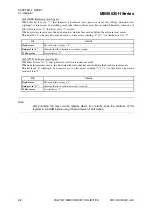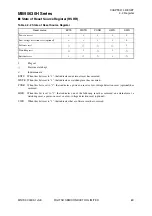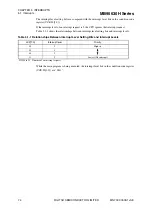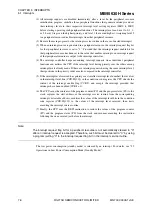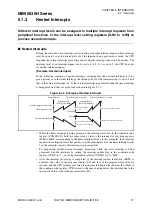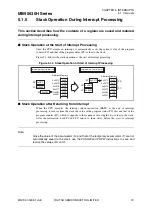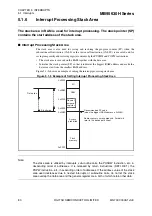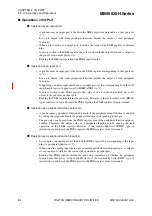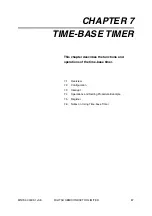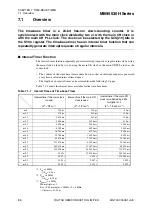
MB95630H Series
76
FUJITSU SEMICONDUCTOR LIMITED
MN702-00009-1v0-E
CHAPTER 5 INTERRUPTS
5.1 Interrupts
(1) All interrupt requests are disabled immediately after a reset. In the peripheral resource
initialization program, initialize those peripheral functions that generate interrupts and set
their interrupt levels in their respective interrupt level setting registers (ILR0 to ILR5)
before starting operating such peripheral functions. The interrupt level can be set to 0, 1, 2,
or 3. Level 0 is given the highest priority, and level 1 the second highest. Assigning level 3
to a peripheral resource disables interrupts from that peripheral resource.
(2) Execute the main program (or the interrupt service routine in the case of nested interrupts).
(3) When an interrupt source is generated in a peripheral resource, the interrupt request flag bit
for that peripheral resource is set to "1". Provided that the interrupt request enable bit for
that peripheral resource has been set to the value that enables interrupts, an interrupt request
of that peripheral resource is output to the interrupt controller.
(4) The interrupt controller keeps monitoring interrupt requests from individual peripheral
functions and notifies the CPU of the interrupt level having priority over the others among
interrupt levels already made. If there are interrupt requests having the same interrupt level,
their positions in the priority order are also compared in the interrupt controller.
(5) If the interrupt level received has priority over (smaller interrupt level number) the level set
in the interrupt level bits (CCR:IL[1:0]) in the condition code register, the CPU checks the
content of the interrupt enable flag (CCR:I), and accepts the interrupt provided that
interrupts have been enabled (CCR:I = 1).
(6) The CPU saves the contents of the program counter (PC) and the program status (PS) to the
stack, captures the start address of the interrupt service routine from the corresponding
interrupt vector table address, modifies the values of the interrupt level bits in the condition
code register (CCR:IL[1:0]) to the values of the interrupt level received, then starts
executing the interrupt service routine.
(7) Finally, the CPU uses the RETI instruction to restore the values of the program counter
(PC) and the program status (PS) from the stack and resumes executing the instruction
following the one executed just before the interrupt.
Note:
The interrupt request flag bit for a peripheral resource is not automatically cleared to "0"
after an interrupt request is accepted. Therefore, such bit must be cleared to "0" by using
a program (writing "0" to the interrupt request flag bit) in the interrupt service routine.
The low power consumption (standby mode) is released by an interrupt. For details, see "3.5







